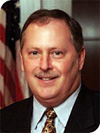Downtown Kansas City: As I See It

The city’s core has been reborn, but new opportunities loom: Let’s seize them.
Throughout the decades-long rise of suburban Kansas City, civic leaders have pushed for a renewed vitality and vibrancy Downtown. As this issue of Ingram’s reflects, Downtown has seen a tremendous amount of activity, particularly over the past eight years. Our challenge is to channel that energy into a cohesive set of policies and practices that will sustain KC’s Downtown for the long haul.
Here are but a few of those developments and thoughts on how we can convert these matters into strong opportunities:
Kemper Arena. As our cover story this month notes, two competing visions have emerged for the future of Kemper and the West Bottoms. Each side makes compelling arguments, but for me, this isn’t a coin-flip decision: The financial and psychological investments we’ve made in Kemper for nearly 40 years are simply too great. We shouldn’t take a wrecking ball to it. We should find a way to utilize that iconic structure to meets the needs of the American Royal, and more important, anchor a community-wide recreational zone that supports continuing redevelopment of the West Bottoms. Frankly, there are plenty of redevelopment opportunities in the West Bottoms, including land adjacent to American Royal assets—find another structure to demolish.
UMKC, Part I: This is where opportunities begin to merge. UMKC has tried for years to raise the profile of its basketball program and achieve true mid-major status, rather than being a Division I also-ran. A big part of that is crafting a fan base that will follow the Kangaroos, and to do that, you need an exciting venue that complements the talent on the basketball court—in an area accessible to residents and recreators. Just down the hill from Downtown and minutes from the Crossroads district sits Kemper Arena. Why not connect those objectives and further enhance UMKC’s status Downtown? A high-profile home court at Kemper Arena on the southwest edge of Downtown in addition to the long-standing presence of the schools of medicine, dentistry, pharmacy and nursing in southeast Downtown, and soon, a performing arts conservatory in the Crossroads District [more to follow] could instantly elevate UMKC’s status. With a stronger basketball program, it could end up in a prominent conference, and become the Missouri university to anchor tournaments Downtown.
Roo, Part II: This edition also includes the Downtown Kansas City Economic Development Report, based on a fascinating 3-hour assembly that drew three dozen of this area’s most influential executives, from both private and public sectors. A clear consensus emerged to move forward on a Downtown home for UMKC’s Conservatory of Music and Dance. Now strewn across four buildings on a cramped campus near the Country Club Plaza, the conservatory could further enhance this community’s artistic reputation, which grabbed headlines nationwide after the opening of the Kauffman Performing Arts Center. Adding 600 full-time students to the Crossroads district could generate demand for additional residential housing needed to drive long-term sustainability, and, a student fan base living close to the Roos’ new home court.
The MU Gap. The time is past for debating the merits of Southeastern Conference membership for the University of Missouri. It’s done. Our challenge is to find ways to leverage the presence of an SEC school just two hours away, and turn it into a positive. A lot of feelings were hurt by the move, and Sprint Center may not see another Big XII tournament and its $15 million economic impact.
But dollars generated by TVs and turnstiles can be powerful inducements to reconciliation. Why not try to bring both conferences to the table here to work out a Big XII-SEC package that would include both football and basketball? MU-Arkansas at Arrowhead could be a great draw; Tennessee is a border state, too, as are three Big 10 states.
KC is uniquely positioned at the nexus of three of the nation’s best athletic conferences and we’re the home to college basketball. Let’s get past the pouting to build something from this. As to KU’s
opinion to not play Mizzou in the future—get over it. The thought of not continuing arguably the strongest rivalry in collegiate sports is absolutely foolish.
The Public-Private Divide: As savvy executives at the Downtown assembly noted, building a new Downtown is like starting a business. You grow it, or you die. We have many of the jewels in the crown now, but we can’t stop here. This will be an ongoing effort, but it has to take on a new financial dynamic. Public subsidies largely made Downtown what it is today.
To make it what we want it to be tomorrow, it will take considerably more private investment. Locating a company Downtown can’t continue to be a decision grounded in the amount of public incentives being offered. Downtown has made its case—and a convincing one—as the place to play, work and even live in the Kansas City area. It’s time for our fiscal policies to reflect that.
It’s exciting to see what’s happened in this city, and Ingram’s has been pleased to have a front-row seat to report on and help drive that change. Here’s hoping that this city can build on this solid foundation to yield bigger and better things in the decades to come. ![]()

Joe Sweeney
Editor-In-Chief & Publisher
JSweeney@IngramsOnLine.com